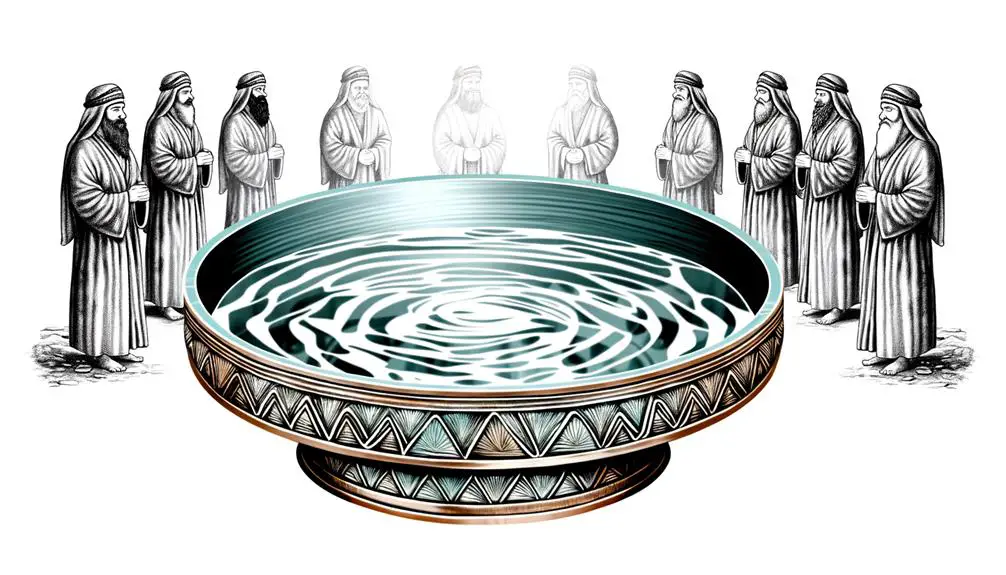Witness the depth of spiritual cleansing through the biblical laver, a vessel of purification with untold layers of symbolic significance.

The Laver in the Bible
As you know, every cloud has a silver lining, and in the intricate tapestry of biblical narratives, the laver holds its unique, often overlooked significance. Positioned within the Tabernacle, and later, the Temple, its role in ritual purification underscores a deeper spiritual cleansing.
You might find it intriguing how this seemingly simple vessel intertwines with the fabric of ancient worship and symbolism. By exploring its dimensions and use, you're on the cusp of uncovering layers of meaning that resonate well beyond its physical presence.
Let's embark on this journey together, uncovering ancient truths that echo into our modern understanding of spirituality and worship.
Key Takeaways
- The laver symbolizes the essential process of spiritual cleansing before engaging in divine worship.
- Its design and craftsmanship reflect the intertwining of spiritual significance with physical beauty and durability.
- Rituals involving the laver underscore the transition from the profane to the sacred, highlighting its role in purification ceremonies.
- The laver's legacy influences modern religious practices, emphasizing the ongoing importance of purification in spiritual life.
Historical Context of the Laver

In exploring the historical context of the Laver, it's crucial to recognize its integral role within the tabernacle's ceremonial purifications, as prescribed in biblical texts. The Laver, essentially a large basin used for the ritual washing of the priests' hands and feet before their service, stands as a testament to the meticulous spiritual preparations mandated in ancient religious practices.
Delving into the manufacturing techniques and geographic origins of the Laver not only unveils the complexity of its construction but also highlights the broader cultural and technological landscape of the period.
The manufacturing techniques employed in creating the Laver were sophisticated, reflecting a high level of craftsmanship. Metalworking practices of the time, particularly those involving bronze, required significant skill. The Laver was made from the mirrors of serving women, as mentioned in Exodus, indicating a unique recycling process that transformed everyday objects into sacred artifacts. This transformation underscores a profound respect for materials and a deep understanding of metallurgy.
Geographic origins play a pivotal role in understanding the Laver's historical context. Situated in the broader Near Eastern region, the Israelites were influenced by surrounding cultures, especially in terms of technological advancements and artisanal skills. The choice of materials and construction methods likely borrowed from the rich tapestry of regional practices, blending local and foreign influences to create a piece that was both functional and symbolic.
Analyzing the Laver through the lens of manufacturing techniques and geographic origins offers a glimpse into the ancient world's complexity. It reveals a society that valued ritual purity, technical skill, and cultural exchange, providing a richer understanding of the tabernacle's ceremonial purifications.
Design and Symbolism

Having explored the intricate manufacturing techniques and geographical origins of the Laver, we now turn our attention to its design and the rich symbolism it embodies within the biblical tabernacle's rituals. The material choice and construction techniques aren't merely functional; they're deeply symbolic, reflecting theological and philosophical ideas central to the ancient faith.
- Material Choice: The selection of bronze as the primary material for the Laver is significant. In biblical times, bronze symbolized strength and durability, suggesting that the rituals associated with the Laver were foundational to sustaining spiritual purity.
- Construction Techniques: The craftsmanship involved in creating the Laver, including its detailed ornamentation, emphasizes the importance of beauty and precision in worship, reflecting the belief that offerings to the divine must be of the highest quality.
- Shape and Size: The circular shape and considerable size of the Laver symbolize completeness and universality, indicating that the path to spiritual purity is accessible to all members of the community.
- Positioning within the Tabernacle: Its strategic placement between the tent of meeting and the altar speaks to its role as a mediator, bridging the human and divine realms through the act of purification.
The design of the Laver, then, isn't just a matter of practicality. It's a profound statement about the nature of holiness, the process of purification, and the relationship between the divine and the earthly. Through its material choice and construction techniques, the Laver serves as a physical and symbolic connector, guiding the faithful in their spiritual journey.
Rituals and Uses

As we delve into the rituals and uses of the Laver, it's crucial to understand how this artifact functioned as a cornerstone in the purification processes prescribed for priests in the biblical tabernacle. The Laver, not merely an object of religious decor, embodied the seamless integration of material sources and cleaning techniques, ensuring the priests' ritual purity before they performed their sacred duties.
Aspect |
Detail |
Significance |
|---|---|---|
Material Sources |
Made from bronze mirrors of serving women |
Reflects dedication and holiness |
Cleaning Techniques |
Water for washing hands and feet |
Symbolizes inner purity and preparedness |
Ritual Purpose |
Mandatory before entering the Holy Place |
Prevents defilement of the sacred space |
Symbolic Meaning |
Transition from worldly to divine |
Emphasizes sanctity and consecration |
The Laver's role extended beyond a mere washing station; it served as a physical and symbolic threshold, separating the profane from the sacred. Through the act of washing, priests were not only cleansed physically but were also prepared mentally and spiritually for the divine service ahead. The materials used in its construction and the prescribed cleaning techniques underscored the importance of purity, reflecting a profound understanding of holiness and dedication.
The Laver in Temple Worship

Exploring the Laver's critical function within temple worship reveals its indispensable role in maintaining the sanctity of religious ceremonies. This intricately designed vessel wasn't just a piece of religious furniture; it was a pivotal element in the spiritual and physical preparation of priests before they engaged in their sacred duties. The Laver's presence and use within the temple underscored a profound respect for purity and a meticulous approach to worship.
Let's delve deeper into the Laver's significance by examining:
- Material sourcing: The choice of materials for constructing the Laver, often bronze or brass, wasn't arbitrary. These materials were valued not only for their durability but also for their symbolic purity and reflectiveness, mirroring the spiritual purity sought by the priests.
- Architectural influence: The placement and design of the Laver within the temple complex was a testament to its importance. Positioned between the altar and the sanctuary, it served as a physical and spiritual intermediary, ensuring that priests were ritually pure before they proceeded to more sacred areas.
- Ritualistic importance: The act of washing at the Laver was integral to temple rituals, a prerequisite for participating in sacrifices and other sacred ceremonies. This practice emphasized the necessity of purification and preparedness in worship.
- Evolution of use: Over time, the Laver's role and design evolved, reflecting changes in worship practices, temple architecture, and material technology. This evolution underscores the adaptive nature of religious observance and the enduring significance of the Laver in fostering a sanctified environment for worship.
In analyzing the Laver's role in temple worship, it's clear its influence extended beyond mere functionality. It was a profound symbol of purity, a critical component in the spiritual lifecycle of the temple, and a significant factor in the architectural and ritualistic framework of ancient worship practices.
Spiritual Significance

The spiritual significance of the Laver in biblical worship transcends its physical form, embodying purity and preparation essential for divine communion. This symbolic vessel, crucial for the ancient rituals, serves as a profound cleansing metaphor within the spiritual framework of the scriptures. Its presence underscores the necessity of purification before engaging with the sacred, a principle that resonates deeply within the fabric of religious practices.
Divine purification, as exemplified by the Laver, isn't merely an external act but a symbolic gesture towards inner sanctification. This concept is pivotal in understanding the Laver's role beyond its physical utility. It represents a bridge between the mundane and the holy, a necessary passage through which the worshippers must transition to achieve spiritual cleanliness. This process of cleansing, therefore, isn't just an act of physical washing but a deeper, symbolic preparation of the self for divine interaction.
Moreover, the Laver serves as a constant reminder of the imperatives set by the divine for those who seek communion. It stands as a testament to the need for spiritual readiness and purity, reinforcing the idea that access to the sacred is conditional upon the purification of the body and soul. This intertwining of physical actions with spiritual meanings elevates the act of washing to a ritualistic expression of the desire for closeness to the divine.
In essence, the Laver's spiritual significance encapsulates the journey of purification required for divine engagement. Its role as a cleansing metaphor extends beyond the literal to underscore the profound interplay between physical purity and spiritual sanctity, a core principle in the pursuit of divine communion.
Legacy and Modern Reflections

You must recognize the enduring influence of the Laver's symbolism, as it transcends its ancient origins to impact cultural significance today.
Its principles have been revisited in contemporary religious practices, showcasing a dynamic blend of tradition and modernity.
Moreover, the Laver continues to inspire artistic expressions, embedding its sacred meanings into diverse forms of creativity.
Cultural Significance Today
Reflecting on its biblical origins, the laver's legacy profoundly influences modern religious practices and interpretations. Its architectural influence is undeniable, shaping the design of contemporary worship spaces and facilitating community gatherings in a manner that echoes its historical role as a place for purification and preparation.
- Architectural Influence: Modern religious buildings often incorporate laver-inspired elements, underscoring the continuity of sacred traditions.
- Community Gatherings: The laver's role in fostering communal activities remains relevant, symbolizing unity and shared purpose.
- Symbolic Representation: It serves as a poignant reminder of the importance of purity and preparation in spiritual practices.
- Educational Tool: The laver is utilized to teach historical and theological concepts, bridging past and present.
The laver's enduring cultural significance demonstrates its capacity to inspire, unite, and educate across generations.
Religious Practices Revisited
Examining the laver's legacy through religious practices offers a window into how these ancient rituals have evolved, yet remarkably retained their essence in modern spiritual life.
Contemporary adaptations of these practices reflect a profound respect for tradition, coupled with a responsiveness to present-day concerns, notably environmental considerations.
The laver, originally a symbol of purification, finds new relevance in rituals that emphasize sustainability and ecological awareness.
This shift illustrates a dynamic interplay between steadfast adherence to spiritual roots and a conscientious adaptation to the challenges of modernity.
Thus, the enduring legacy of the laver in religious practices isn't merely in its historical significance but in its capacity to inspire a meaningful, contemporary spiritual expression that acknowledges and addresses the pressing environmental issues of our time.
Artistic Inspirations Derived
The laver's influence frequently extends beyond religious practices, inspiring a rich tapestry of artistic expressions that reflect its enduring legacy and modern reinterpretations. This sacred vessel has been a muse for artists and thinkers, guiding them toward exploring themes of purification, reflection, and divine interaction within their works. The blend of historical reverence and contemporary artistry illuminates the laver's multifaceted significance in modern interpretations, offering fresh perspectives on ancient wisdom.
- Sculptures that embody the laver's symbolism, merging biblical motifs with avant-garde techniques.
- Paintings that capture the reflective essence of the laver, inviting contemplation.
- Installations that reinterpret the laver's purpose in interactive and immersive experiences.
- Digital artworks that utilize modern technology to explore the laver's themes, bridging the gap between ancient tradition and contemporary digital culture.
Frequently Asked Questions
How Did the Process of Constructing the Laver Differ From the Construction of Other Tabernacle Furnishings in Terms of Materials and Craftsmanship?
When constructing the laver, unlike other furnishings, the materials and craftsmanship took a unique turn. Crafters used mirror reflections from women's donations, unlike the standard gold, silver, or bronze. This choice not only elevated its aesthetic but also its function, reflecting light and enhancing clarity around water sources.
This method showcased a distinct approach, prioritizing both practical needs for purification and the symbolic representation of purity and reflection, setting it apart in craftsmanship and intention.
Are There Any Recorded Instances Where the Laver Was Used in a Manner Not Prescribed by Biblical Law, and if So, What Were the Consequences?
You're delving into the usage of ritual objects beyond their intended purposes. While specific instances of the laver's misuse aren't detailed, its construction from mirrors and its role in purification underscore its ritual significance. Deviating from prescribed uses likely led to consequences, emphasizing respect for sacred materials and rituals.
Analyzing such deviations offers insights into the dynamic relationship between religious objects, their intended uses, and the community's adherence to divine commands.
How Has the Understanding and Interpretation of the Laver's Symbolism Evolved in Different Jewish and Christian Denominations Over the Centuries?
You're delving into the evolution of the laver's symbolism across Jewish and Christian groups. Its ritual significance has morphed, reflecting diverse denominational practices.
Initially, its role was clear-cut, but over centuries, interpretations have broadened. Some see it as a mere historical relic, while others imbue it with profound spiritual meanings.
This shift underscores the dynamic nature of religious symbols, showing how traditions adapt and reinterpret foundational elements to align with contemporary beliefs.
In What Ways Have Contemporary Artists and Architects Been Inspired by the Laver's Design for Modern Religious and Secular Structures?
In the realm of design, modern adaptations and artistic reinterpretations have drawn inspiration from timeless structures. Contemporary artists and architects, captivated by the elegance of historical designs, have infused their modern religious and secular buildings with echoes of the past.
These modern interpretations not only pay homage to traditional motifs but also blend them innovatively with contemporary aesthetics, showcasing a seamless merger of age-old inspiration with cutting-edge design principles.
Can the Concept of the Laver Be Found in Religious Traditions Outside of Judaism and Christianity, and How Is It Interpreted or Represented in Those Contexts?
Yes, the concept akin to the laver indeed exists in other religious traditions. In Hindu rituals, you'll find the use of sacred water in cleansing practices before worship, symbolizing purification.
Similarly, Islamic ablutions involve washing certain body parts before prayer, reflecting a physical and spiritual cleansing process.
Both practices echo the laver's symbolic meaning of preparation and purification, albeit interpreted within their unique theological and cultural contexts.
Conclusion
In essence, the laver stands as a mirror to the soul, reflecting purity and divine preparation. Through its waters, the ancient rites whisper of transformation, urging you to wash away the temporal and embrace the spiritual.
It's more than a vessel; it's a bridge between the earthly and the divine, a testament to the enduring quest for sanctity. As you ponder its legacy, let its ripples touch your modern reflections, guiding you towards a more profound, sacred understanding of your journey.



Sign up